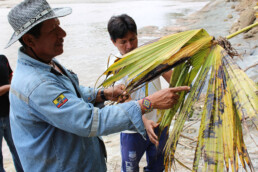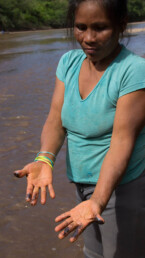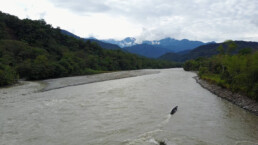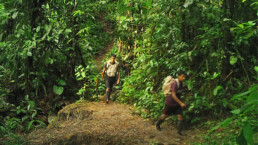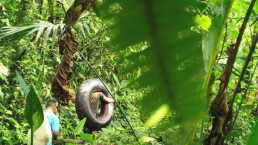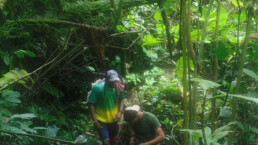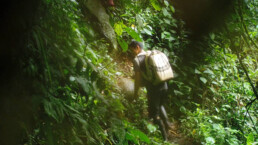What Do We Know About How Oil Spills Affect Human Health? Not Enough.

Planes, trains and automobiles. Plastic, pesticides and polyester. Oil and gas have been the engine of the world economy for 100 years. Despite this, we know little about the health impacts of spills and purposefully discharged oil waste. Why is this? Because not one long-term study has been carried out with residents living near spills or workers who have cleaned up spills. Not one.
Several good, short-term studies have been carried out, however, and what they tell us is troubling. These studies report on health impacts in people exposed to oil and gas from several of the most notorious spills in history: Exxon Valdez, Hebei Spirit, Tasman Spirit, Prestige, and Deepwater Horizon. The portrait they paint is alarming. They are like the iridescent sheen of an oil slick on the surface that entreats us to dig deeper to uncover the enduring effects of contact with oil and gas.
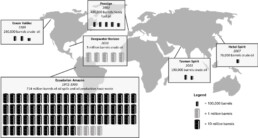
Notorious Oil Spills: When a tanker sinks or a rig close to the United States blows we hear a lot about it in the media, but none of the most notorious spills even come close to the amount of oil and toxic wastes that have been dumped into the Ecuadorian Amazon over the years.
For the past 50 years, the people living in the northern Ecuadorian Amazon have been the victims of countless spills and the irresponsible waste management practices of the companies extracting oil in the region. Between 1972 and 1993, 714 million barrels (or 30 billion gallons) of oil and toxic waste have been purposefully or accidentally released into the environment. While none of the individual spills measure up to the infamous spills named above, over the years they have added up to more than 140 times the 2010 BP Deepwater Horizon spill in the Gulf of Mexico. What’s more, this ‘slow-drip’ means that people are in near-constant contact with oil and waste products. Even less is known about the health impacts of this relentless contact with oil, but the short-term studies carried out on the large-scale spills can give us a clue as to what might be happening among indigenous peoples of the region.
Oil spill near the Kofán community of Avie.
Health impacts of oil spills
Published studies have looked at both self-reported symptoms and biomarkers (laboratory results from samples) in people who came into contact in some way with oil or gas following spills (Aguilera et al. 2010; D’Andrea and Reddy 2014; Laffon et al. 2016; for a recent review see Ramirez et al. 2017). Self-reported symptoms can be grouped into respiratory problems, irritations (eye, skin, etc.), neurological effects (headache, dizziness, etc.) and traumatic symptoms (pain). Symptoms were, in many cases, related to the intensity of the exposure. In other words, the closer the person was to the spill or the more time they spent near the spill, the greater the symptoms. These findings suggest that each time local Ecuadorian Amazonian people are exposed to a spill they suffer these same symptoms. The nonstop contact with oil among indigenous people in the northern Ecuadorian Amazon would presumably have a cumulative effect, making individuals more vulnerable once an accident occurs.
Self-reported skin rashes from contact with an oil spill.
Studies of biomarkers have uncovered irreparable harm to humans exposed to oil and gas from spills. These effects can be grouped into respiratory damage, liver damage, decreased immunity, increased cancer risk, reproductive damage and higher levels of some toxics (hydrocarbons and heavy metals).
The only study looking at Amazonian indigenous people’s health markers following a spill was carried out in the Peruvian Amazon four months after a localized spill (Webb et al. 2016). The study showed that men who had worked cleaning up the spill had twice as much mercury in their urine as did men who had not been involved in the effort to restore the lagoon in which the oil had stagnated. Mercury damages the brain and the liver. Each time a pipeline ruptures or a waste pit overflows, we could expect that the people in the vicinity are flooded with mercury, through their water, the fish they eat, and the air they breathe. Several other studies conducted in the Ecuadorian Amazon have linked proximity to oil operations with illness (such as cancer, skin irritations, etc.) (San Sebastian et al. 2001; 2004; Hurtig et al. 2004; Paz-y-Miño et al. 2008). While the studies were not linked to a specific spill, they were carried out in areas having borne numerous accidents. Two studies, both financially supported by Chevron, unsurprisingly, found no link between cancer and oil extraction (Kelsh et al. 2009; Moolgavkar et al. 2014).
Where do we go next?
The longest-term study ever carried out followed fishers six years after the Prestige oil spill off the coast of Spain and evaluated respiratory health effects. A clinical study looking at the effect of water from the Gulf of Mexico following the Deepwater Horizon oil spill found that human lung cells grown in the water, which contained both the spilled oil and oil dispersants, showed signs of damage, pointing to some of the ways in which oil and dispersants wreak havoc on the human body. From other clinical studies (on mice and cells) we know that one of the main health effects of hydrocarbons, the principal component of oil, is cancer. In order to capture cancer rates, studies need to run for an extended period of time. A longitudinal (long-term) study on the impacts of oil spills is needed.
What can you do?
Reducing the demand for oil is the best way that individual citizens can reduce the number of spills. In order to reduce your consumption, take public transportation, eat local, eat lower on the food chain (vegetarian), and consume less. You can also demand that your institutions (bank, school, municipality) divest from oil companies. Amazon Frontlines is working with the indigenous organization Ceibo Alliance to help indigenous people know what risks they face. Knowing the risks is the first step in being able to take action to defend indigenous rights to health and demand greater environmental protections in the Amazon. See the work of our Environmental Monitoring and contribute to this work here.
Reference list
- Aguilera F, Méndez J, Pásaro E, Laffon B (2010) Review on the effects of exposure to spilled oils on human health Journal of Applied Toxicology 30:291-301 doi:10.1002/jat.1521
- D’Andrea MA, Reddy GK (2014) Crude oil spill exposure and human health risks Journal of occupational and environmental medicine 56:1029-1041
- Hurtig A-K, San Sebastián M (2004) Incidence of Childhood Leukemia and Oil Exploitation in the Amazon Basin of Ecuador Int J Occup Environ Health 10:245-250
- Kelsh M, Morimoto L, Lau E (2009) Cancer mortality and oil production in the Amazon Region of Ecuador, 1990–2005 Int Arch Occup Environ Health 82:381-395
- Laffon B, Pásaro E, Valdiglesias V (2016) Effects of exposure to oil spills on human health: updated review Journal of Toxicology and Environmental Health, Part B 19:105-128
- Moolgavkar SH, Chang ET, Watson H, Lau EC (2014) Cancer mortality and quantitative oil production in the Amazon region of Ecuador, 1990–2010 Cancer Causes Control 25:59-72 doi:10.1007/s10552-013-0308-8
- Paz-y-Miño C, López-Cortés A, Arévalo M, Sánchez ME (2008) Monitoring of DNA Damage in Individuals Exposed to Petroleum Hydrocarbons in Ecuador Ann N Y Acad Sci 1140:121-128 doi:10.1196/annals.1454.013
- Ramirez MI, Arevalo AP, Sotomayor S, Bailon-Moscoso N (2017) Contamination by oil crude extraction – Refinement and their effects on human health Environmental Pollution 231:415-425 doi:https://doi.org/10.1016/j.envpol.2017.08.017
- San Sebastian M, Armstrong B, Cordoba JA, Stephens C (2001) Exposures and cancer incidence near oil fields in the Amazon basin of Ecuador Occupational & Environmental Medecine 58:517-522
- San Sebastian M, Hurtig AK (2004) Oil exploitation in the Amazon basin of Ecuador: a public health emergency Rev Panam Salud Publica 15:205-211
- Webb J, Coomes OT, Mergler D, Ross N (2016) Mercury Concentrations in Urine of Amerindian Populations Near Oil Fields in the Peruvian and Ecuadorian Amazon Environmental Research 151:344-350
List of chronicles in our Health on the Frontlines series:
Nothing found.
Be a Champion for the Amazon!
Start a fundraising campaign to drive resources to Indigenous Earth Defenders on the frontlines
Confronting illegal mining in ancestral Kofan land, Ecuadorian Amazon
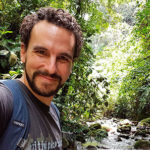
The waves of the Upper Aguarico River are crashing on both sides of our boat, filling it with cold water rushing straight from the Andes, which stand tall in front of us. The puntero barks and points directions to the motorista in order to avoid smashing into one of the many boulders in our way, and my heart pumps fast with the adrenaline rush. My eyes feast on the wild landscape while my mind races: Where are they? Will we meet the same ones? How should we react if they become aggressive?
The land patrol of Sinangoe travels up the Aguarico River towards an area known to the Kofan people as a “hotspot” for illegal gold mining, hoping to stop what seems to have become an “Amazonian Gold Rush” on their ancestral land.
The land patrol of Sinangoe travels up the Aguarico River towards an area known to the Kofan people as a “hotspot” for illegal gold mining, hoping to stop what seems to have become an “Amazonian Gold Rush” on their ancestral land.
It is the fifth time in a little more than a month that our team has traveled to this far corner of the Amazon, in the mega-diverse foothills of the Ecuadorian Andes. This area has been the traditional Kofan territory of Sinangoe since time immemorial, more recently designated by the Ecuadorian government as the Cayambe-Coca National Park. If you close your eyes and think of the Amazon, Sinangoe represents everything you can imagine: rich indigenous culture, splendid wildlife, ancient lianas and giant trees, beautiful landscapes… And a lot of rain, falling in sporadic downpours and fueling hundreds of streams, waterfalls and rivers.
However, behind the luxuriant curtain of the jungle, hides a disconcerting reality: While the patch of green that represents the National Park might look nice on a map, illegal miners, fishermen and poachers are currently roaming inside Sinangoe’s land without consent from the community or any meaningful control from the government — and the Kofan people have had enough. Our team, composed of Sinangoe’s leaders and land defenders, is on the lookout.
Monitoring the elusive “homo illegalis”
We have reached the section of the river where boats can go no further, and are now walking on a trail that seems to be used every day by dozens of people. Footprints in the mud, an oddly broken branch, new trails leading deeper in the jungle, an empty shotgun cartridge, remnants of a makeshift camp, garbage left in a clearing… The signs of the “Amazon gold rush” are obvious, even for a foreigner like me. The Kofan people have been walking these woods for millennia, but rarely have they seen so many indications of the ongoing occupation of their land by the “cucamas”- the “outsiders.”
Facing increased pressure on their land, the Kofan people of Sinangoe have decided to work with the Ceibo Alliance and Amazon Frontlines in a monitoring project aimed at detecting, documenting and denouncing illegal activities in their traditional territory. Through the use of community land patrols, camera trap photos and videos, drone footage, satellite imagery and territorial mapping, the community is channeling reliable, evidence-based, real-time information about invaders to help decision-making processes in order to defend their ancestral land.
The team of Kofan land defenders from Sinangoe has been using camera traps, drones, GPS and video cameras to detect illegal activities on their ancestral land.

The team of Kofan land defenders from Sinangoe has been using camera traps, drones, GPS and video cameras to detect illegal activities on their ancestral land.
After walking for fifteen minutes, we reach the first camera trap, well hidden in the trees. Trepidation takes over our team. Since we installed the camera two weeks ago, it has been very active: The small lcd screen indicates that the memory card is filled with 168 pictures and videos. Triggered by movement and equipped with heat sensors, these camera traps are usually used to detect wildlife, but we have adapted our monitoring to detect another kind of species: homo illegalis- the illegal colonist invader. And it seems our first camera of the day will provide very valuable clues on the habits of this elusive species.
Settled on a big rock close to a stream, the team focuses on the laptop we downloaded the images onto, hoping the approaching rain clouds above don’t bring a quick end to our improvised forest desk. Flipping through the gallery, the faces of my Kofan colleagues change from excitement to awe to indignation. The pictures and videos show dozens of intruders on this very spot, walking in pairs or in groups of up to eight people, some with gasoline tanks, others with shotguns, shovels or pickaxes, all heading upriver at dawn and coming back down at dusk, sometimes two or three days after they first walked by.
Over the course of less than four months of monitoring, from February to May 2017, the Kofan people of Sinangoe have detected more than 70 people, often working in groups, participating in illegal activities on their ancestral land.
We’re snacking on crackers as we look at the faces of the illegal miners and poachers on the screen while the elders of the group give us information as to who these people are. Some of them are well known colono neighbors of Sinangoe, but many faces are unknown to the team, a sign that things might be getting out of control. Moreover, some of the illegal miners that triggered our camera traps have been previously warned by our team many times yet continue to show up. It seems like the message still isn’t getting across.
When words don’t mean anything anymore
We are back on the trail, going upstream along the Upper Aguarico River, when someone in our group stops, pointing with his finger to his ear. We all stop and listen carefully. At first, I can hear nothing else other than the constant variety of jungle sounds- crickets, birds, cicadas and frogs. But after a while I catch it, behind the general din, a humming sound that can only be coming from one thing: a motor. We decide to go to the river bank, towards the sound.
One of our team members sees something move, about 500 meters from where we are standing. Instead of going right away to confront whomever it might be, we decide to fly the drone and get a peek of what is going on upstream. After a two-minute flight, the drone shows us the source of the noise. On a small stream leading to the main River, deep into Sinangoe’s ancestral land, three men are illicitly digging the pristine shore with a dredger in the hope of finding gold. Having visited this site two weeks earlier, we can see that they have transformed the landscape considerably.
Caught by our drone hiding in the trees, a group of illegal miners are dredging a small catchment of the Upper Aguarico River, deep into ancestral Kofan land and inside the Cayambe-Coca National Park.
Caught by our drone hiding in the trees, a group of illegal miners are dredging a small catchment of the Upper Aguarico River, deep into ancestral Kofan land and inside the Cayambe-Coca National Park.
Even though we are filming from a considerable height, it seems the miners have heard the drone and hurry to hide in the trees. We bring the drone back to us, and decide to go straight to the men to have a talk. After a five-minute walk, we arrive at the dredger, which had been shut down, and realize the illegal miners are actually the same ones who told us a week-and-a-half ago that they never used machinery and would not come back to the area.
There is obvious discomfort in the air.
Sinangoe’s land patrol has warned dozens of illegal goldminers in the past months, asking them to respect their ancestral land and not exploit resources without their consent. In this exchange, a goldminer responds to the question “why are you coming to the very place the community says not to come, where the government says not to come and where you have no permit to do such mining?” The answer: “Let’s be honest, we are taking advantage of the situation… but give us one last chance and we will leave”.

Sinangoe’s land patrol has warned dozens of illegal goldminers in the past months, asking them to respect their ancestral land and not exploit resources without their consent. In this exchange, a goldminer responds to the question “why are you coming to the very place the community says not to come, where the government says not to come and where you have no permit to do such mining?” The answer: “Let’s be honest, we are taking advantage of the situation… but give us one last chance and we will leave”.
From what we see, the men have been at work for many days. We can make out their makeshift camp in the trees, not far away. Once again, we all sit to have a talk — the Kofan always polite and calm; the miners, apologetic and defensive. Why are they coming back to the very place where the Kofan asked them not to come? Their answer is quite straightforward: “Let’s be honest, we are taking advantage of the situation… But give us one last chance and we will leave”.
The problem is, this conversation sounds like a broken record, and everyone in the group knows it.
Indigenous legal strides against colonists’ illegal mining
Fed up with these kinds of encounters and of so many other abuses over the years, and the total lack of support from Ecuadorian authorities, the community of Sinangoe decided in May 2017 to adopt its own indigenous law and to put in place a formal land patrol to monitor and stop illegal activities on their land. Made public in September 2017, this new legal tool, supported by Ecuadorian Constitution and international treaties, prohibits any mining, poaching, fishing or logging by non-Kofan people on their land and sets strict rules on how invaders should be treated.
The entire community of Sinangoe have unanimously adopted its indigenous law in May 2017 in order to stop illegal activities inside their ancestral land.
As a direct response to these legal strides and the publicity it attracted, the local, provincial and national authorities have been forced to react, starting investigations and going with Sinangoe’s land patrol on the field to witness the illegal activities with their own eyes. Unfortunately, to this date, not one authority – either from the Ministry of the Environment, the “Defensoria del Pueblo” or the local or National Police – have acted against any of the invaders or set any sanctions.
However, illegal miners have since had to think twice before crossing into Sinangoe’s land, and the community has observed a drastic drop in invasive activities since they publicized their law in September 2017. Meanwhile, the land patrol keeps on walking their woods, constantly on the lookout for any infringement on their ancestral land.
In the early months of 2018, Sinangoe’s land patrol have found what they have feared for years: it seems like the reputation of the area as a good “gold spot” has reached bigger players’ ears. From one day to the next, big machinery has appeared on the very edge of their land, new mining concessions have been granted without any prior consultation. Definitely, this fight is far from over…
For the Kofan of Sinangoe, standing up in defense of their territory requires courage and it requires solidarity. Stand with Sinangoe by signing and sharing our pledge.
List of chronicles in our series on Sinangoe:
Nothing found.

